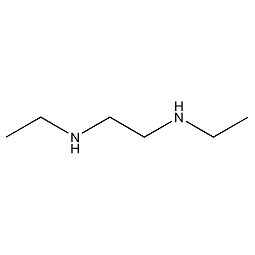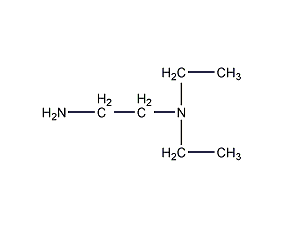N,N’-Diethylethylenediamine N,N’-Diethylethylenediamine


Structural formula
| Business number | 0346 |
|---|---|
| Molecular formula | C6H16N2 |
| Molecular weight | 116.20 |
| label |
N,N’-Ethylenediethyldiamine, 1-2-Bis(ethylamino)ethane, Auxiliary |
Numbering system
CAS number:111-74-0
MDL number:MFCD00009033
EINECS number:203-902-4
RTECS number:None
BRN number:None
PubChem number:24847751
Physical property data
1. Characteristics: Colorless liquid
2. Density (g/mL,35℃): 0.8211
3. Relative vapor density (g/mL,air =1): Not determined
4. Melting point (ºC): Undetermined
5. Boiling point (ºC,Normal pressure):145.2
6. Boiling point (ºC,0.023kPa): Not determined
7. Refractive index: 1.4360
8. Flashpoint (ºC): 30
9. Specific rotation (º): Undetermined
10. Autoignition point or ignition temperature (ºC): Undetermined
11. Vapor pressure (mmHg,20ºC): Undetermined
12. Saturated vapor pressure (kPa,25ºC): Undetermined
13. Heat of combustion (KJ/mol): Undetermined
14. Critical temperature (ºC): Undetermined
15. Critical pressure (KPa): Undetermined
16. Oil and water (octanol/Log value of the partition coefficient for water: undetermined
17. Explosion on�(%,V/V): Undetermined
18. Lower explosion limit (%,V/V): Undetermined
19. Solubility:Miscible with water, soluble in ethanol and ether and general organic solvents.
Toxicological data
None
Ecological data
This substance is slightly harmful to water bodies.
Molecular structure data
5. Molecular property data:
1. Molar refractive index: 37.03
2. Molar volume (m3/mol):145.2
3. isotonic specific volume (90.2K):326.7
4. Surface Tension (dyne/cm):25.6
5. Polarizability(10-24cm3):14.68
Compute chemical data
1. Reference value for hydrophobic parameter calculation (XlogP): None
2. Number of hydrogen bond donors: 2
3. Number of hydrogen bond acceptors: 2
4. Number of rotatable chemical bonds: 5
5. Number of tautomers: none
6. Topological molecule polar surface area 24.1
7. Number of heavy atoms: 8
8. Surface charge: 0
9. Complexity: 31.5
10. Number of isotope atoms: 0
11. Determine the number of atomic stereocenters: 0
12. Uncertain number of atomic stereocenters: 0
13. Determine the number of chemical bond stereocenters: 0
14. Number of uncertain chemical bond stereocenters: 0
15. Number of covalent bond units: 1
Properties and stability
Prohibited withStrong oxidants, strong acidsContact.
Storage method
Stored in a cool, ventilated warehouse. Keep away from fire and heat sources. Keep container tightly sealed. They should be stored separately from oxidants, acids, and alkalis, and avoid mixed storage. Use explosion-proof lighting and ventilation facilities. It is prohibited to use mechanical equipment and tools that are prone to sparks. The storage area should be equipped with emergency release equipment and suitable containment materials.
Synthesis method
It is obtained by hydrolysis, addition and degradation of acrylonitrile; another production method is to obtain this product by hydrogenation of ethylenediaminoacetonitrile.
Purpose
Used as an intermediate for fine chemicals, it can produce the antiarrhythmic drug procainamide and the local anesthetic dibucaine hydrochloride And enzyme inhibitors and so on. It is also used to produce auxiliary products, for example, it is used to prepare Sapamine BCH.
/SPAN>): 326.7
4. Surface Tension (dyne/cm):25.6
5. Polarizability(10-24cm3):14.68
Compute chemical data
1. Reference value for hydrophobic parameter calculation (XlogP): None
2. Number of hydrogen bond donors: 2
3. Number of hydrogen bond acceptors: 2
4. Number of rotatable chemical bonds: 5
5. Number of tautomers: none
6. Topological molecule polar surface area 24.1
7. Number of heavy atoms: 8
8. Surface charge: 0
9. Complexity: 31.5
10. Number of isotope atoms: 0
11. Determine the number of atomic stereocenters: 0
12. Uncertain number of atomic stereocenters: 0
13. Determine the number of chemical bond stereocenters: 0
14. Number of uncertain chemical bond stereocenters: 0
15. Number of covalent bond units: 1
Properties and stability
Prohibited withStrong oxidants, strong acidsContact.
Storage method
Stored in a cool, ventilated warehouse. Keep away from fire and heat sources. Keep container tightly sealed. They should be stored separately from oxidants, acids, and alkalis, and avoid mixed storage. Use explosion-proof lighting and ventilation facilities. It is prohibited to use mechanical equipment and tools that are prone to sparks. The storage area should be equipped with emergency release equipment and suitable containment materials.
Synthesis method
It is obtained by hydrolysis, addition and degradation of acrylonitrile; another production method is to obtain this product by hydrogenation of ethylenediaminoacetonitrile.
Purpose
Used as an intermediate for fine chemicals, it can produce the antiarrhythmic drug procainamide and the local anesthetic dibucaine hydrochloride And enzyme inhibitors and so on. It is also used to produce auxiliary products, for example, it is used to prepare Sapamine BCH.
>(Sapamine BCH).
